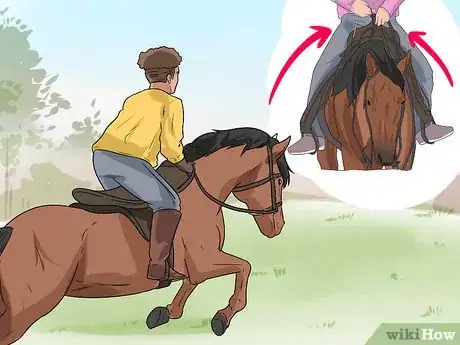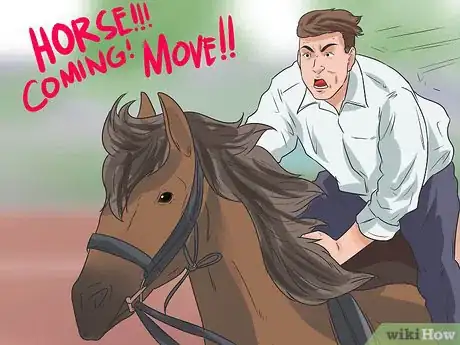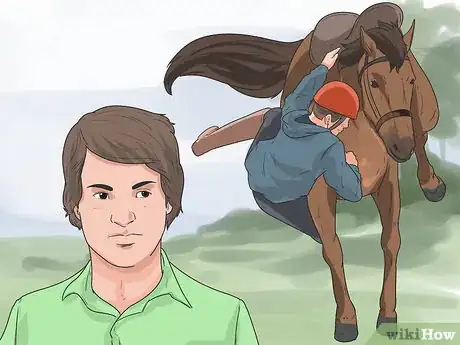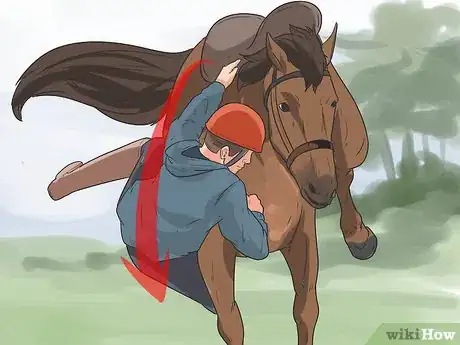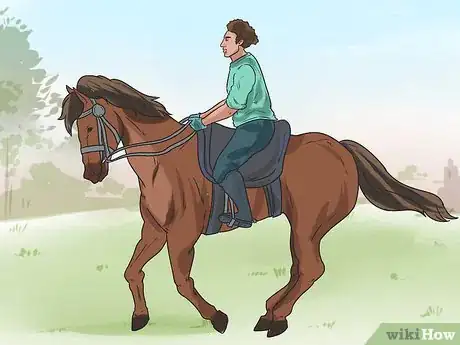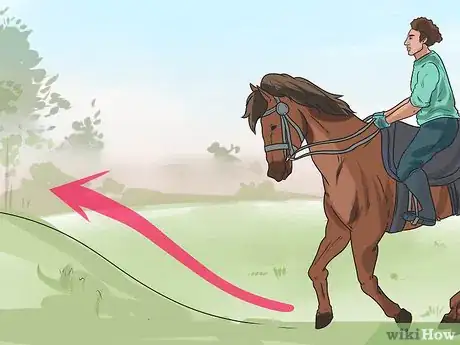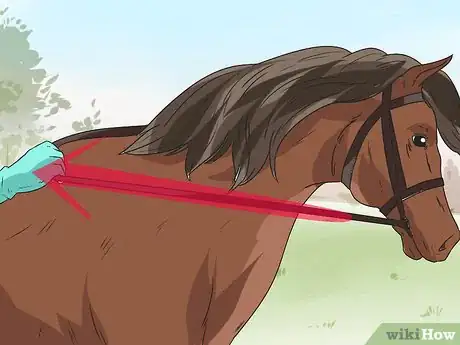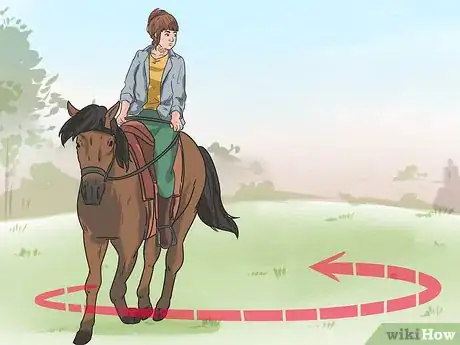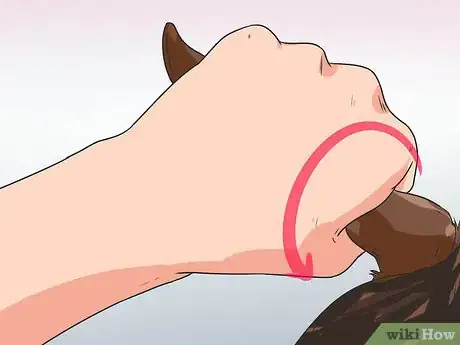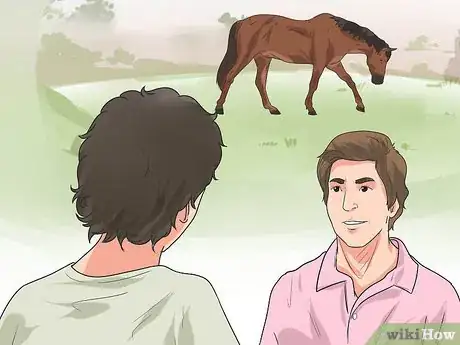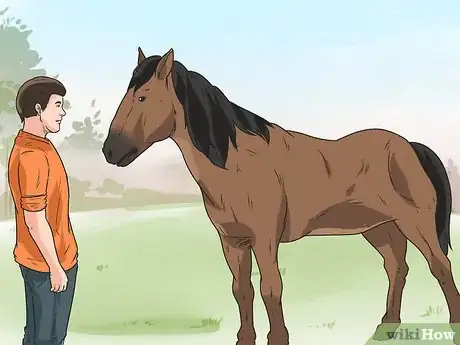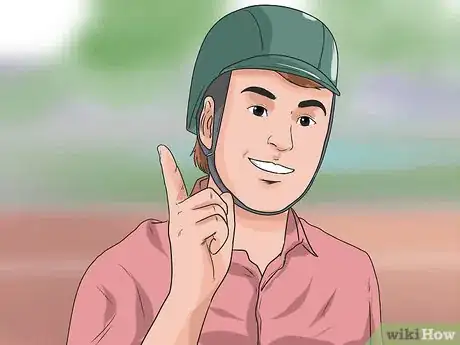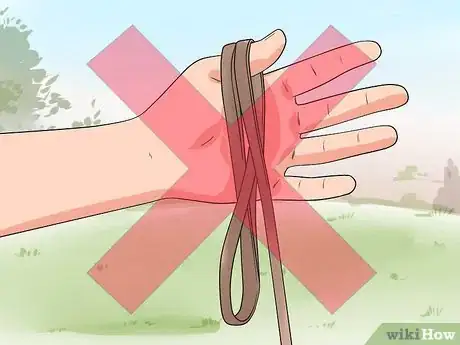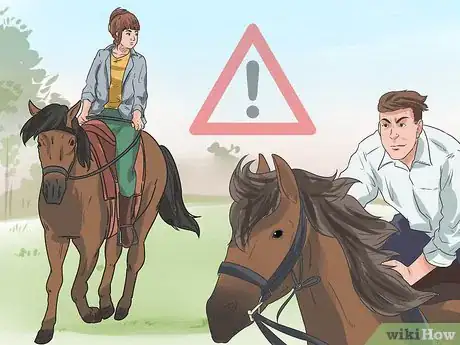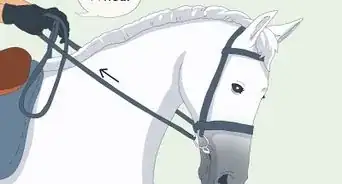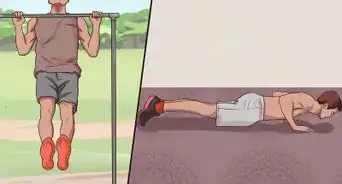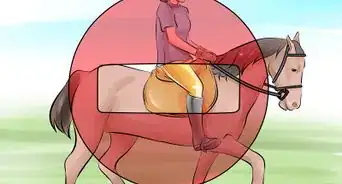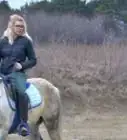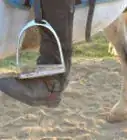This article was co-authored by wikiHow Staff. Our trained team of editors and researchers validate articles for accuracy and comprehensiveness. wikiHow's Content Management Team carefully monitors the work from our editorial staff to ensure that each article is backed by trusted research and meets our high quality standards.
This article has been viewed 51,689 times.
Learn more...
Horseback riding is a lot of fun, great exercise, and a great way to relieve stress. Sometimes, it can also be dangerous, such as when your horse unexpectedly begins a full-out run while you are riding, and you cannot seem to regain control. This might happen, for example, if the horse is poorly trained or if she is suddenly startled. It can be very dangerous for your horse and for you as the rider, as horses sometimes run through traffic or attempt to jump fences, streams, or bushes out of fear. There are several things you should do in order to stay as safe as possible in this type of situation.
Steps
Knowing What To Do First
-
1Regain your balance. Whether your horse has started racing the others in the ride or has been suddenly spooked, you need balance before you can think about slowing your horse down properly. Balance in the saddle will help to assure you are not thrown off.
- If you have lost your stirrups, do your best to get them back. Having your feet planted in the stirrups helps with both balance and control of the horse.
- Try to relax your muscles, including your arms that are holding the reins. Let your body feel the rhythm of the running horse. Otherwise, you will bounce in and out of your saddle and may fall off the horse.[1]
- Leaning forward might give you better balance, but when you need real pulling power lean back slightly.
-
2Check your surroundings. You are responsible for the damage your horse causes (or the damage caused to it) so look out for joggers, cyclists, dogs, corners, holes, fences, sharp rocks, other horses, terrain that can damage your horse's feet, terrain that can cause it to jump and obstacles that can scare it further (including seemingly benign things like a sprinkler or a flag) or encourage it to speed up. Be aware and try to steer clear of them.
- If there are cyclists, joggers, or other pedestrians nearby, scream "HORSE COMING! MOVE OUT OF THE WAY!" for a warning and do your best to steer your horse away from people or other obstacles.
- If you need to distract your horse for a second while you pass an object that you know will scare it, jiggle the reins roughly. Try to annoy him with the movement by flicking the reins excessively rather than yanking and encouraging resistance. Turn their head away slightly if you can.
Advertisement -
3Evaluate the situation. As you make quick mental notes about the severity of the situation (factoring in details like why your horse is bolting, what hazards are around, and your own experience level), you have to make a snap decision about whether to stay on the horse. Should you abandon ship or will you be able to stay on and slow down?
- Remember, jumping off can injure you. You will almost definitely have severe bruising and scraping, and you could break your arms, legs, or even your back or neck. You should only jump off of a horse if the risk of staying on is greater than the risk of jumping off.
-
4Jump off only if necessary. If you do decide that the danger of staying on your horse is too great, jump off. If possible, choose a place with a soft landing (a bush rather than a rock).
- Kick your feet out of the stirrups first, unwind the reins from your hand, and tumble.
- After you are off and in a safe place, you will have to find your horse.
Regaining Control of Your Horse
-
1Let your horse run. If you are in a safe place (like a big, flat, open field), your horse is likely to run for a bit and eventually calm herself down. Just stay on, stay calm and let them get it out of their system.
- Hold on tight, and put your body in a proper position for galloping.
-
2Aim for steep upward slopes if you can. Horses can't run fast uphill, so doing this will slow the horse's run and help you regain control.
- Avoid downhill if you can. It is jarring and can unseat you, and can cause a horse to tumble.
-
3Try a pulley rein. This is one strategy that you should only use slowing a running horse. It works by applying leverage to the horse's mouth.
- Tighten the rein in your non-dominant hand so that it has no slack. Your hand should be centered on the horse's main with your knuckles against the horse and the rein completely taut. This will prevent the horse from jerking his head away from you.
- Keeping a tight grip with your non-dominant hand, lean forward as far as you can on the horse's neck and reach up on your dominant side and grab the rein as close to the horse's mouth as you can reach.
- Pull back with your dominant hand as hard as you can, using all of your body weight and leaning back into the saddle. This pulls the horse's head down and forces a stop.
- Ease your hold on the reins as soon as the horse stops or you risk the horse falling over and crushing you.
-
4Try turning the horse in circles. This will only work if she is going slow enough, as otherwise it can be very dangerous, so judge whether your horse is moving slow enough for a safe turn.
- Shorten your inside rein dramatically and yank-yank-yank. Very Hard. Turn in the smallest circle you can manage, and when he sufficiently drunk step out of it on a tight rein.
-
5Twist your horse's ear. This is a last resort, but might be necessary if all else fails. Twisting a horse's ear (pulling the tip down to the ear's base and squeezing the fold) releases hormones that chills the horse out. The same principle is used in a twitch (on the horse's nose) and twisting an ear helps in an emergency (like a horse that has cast himself).
- Lean forward and grab an ear. Fold it and hold it. Don't do this straight through (he might just stagger) hold a while (no more than five seconds should do it) release it for ten, hold it five and so forth.
Taking Precautions Before a Bolt
-
1Let others know you are out for a ride. Better yet, until you are very experienced at riding, never go for a ride alone. Ask an experienced rider to go with you.[2]
- Another rider can help you slow a runaway horse, or can get help if you are injured in a ride.
-
2Ride a trusted mount. Particularly if you are inexperienced at riding, do not ride a horse that is untrained or not fully broken.
- You should always ride a horse that is at your skill level, and you should get to know the horse and its personality before riding. Some horses startle easily or exaggerate their responses to a pull on the reins or a tap on the sides.[3] Riding a laid-back, well-tested horse is the safest way to avoid your horse bolting unexpectedly.
-
3Wear a helmet. Horseback riding, like any sport, carries some potential for injury no matter how cautious you are. Wearing a helmet will protect your head from injury if you happen to be thrown from your horse or if you have to make an emergency jump from a running horse. One study found that horseback riders not wearing helmets were four times more likely to die due to injuries from riding than those who wore helmets.[4]
- Attractive riding helmets are easy to find if you ride English style. While less common for Western-style riders, helmets are still important for safety; you can wear an English style helmet or another helmet approved for riding. Look for the letters ASTM-SEI, which indicates the helmet has been safety-approved.[5]
-
4Never wrap the reins around your hand. Although it seems like this would increase your grip and make you less likely to fall, it can also lead to a severed or disjointed hand if there is a true emergency.[6]
- Hold the reins securely with one hand, and hold the saddle horn with your other hand. NEVER let go of the reins and horn while riding.
- Wearing riding gloves can increase your grip on the reins and make it less likely that they will slip from your grasp.[7]
-
5Stay alert. Just as you should do while driving a car, an alert horseback rider should stay alert and constantly rehearse scenarios in her mind of what she would do in case of emergency. As you ride, think about what you would do if your horse suddenly bolted at any given point in the ride.
- Watch your surroundings for safe routes, avoiding areas that would be hazardous if your horse suddenly bolted (for example, avoid riding your horse near vehicular traffic or near cliff edges).
Community Q&A
-
QuestionWhat would I do if my horse started doing this on a busy main road?
 Community AnswerAs soon as you can, you need to turn his head (in whatever direction) and make his head almost touch your leg in the stirrups. Bring your hand to your hip to make him turn his head in that direction, and keep holding your hand there until he comes to a stop. It is almost impossible for horses to gallop forward while their heads are turned sideways.
Community AnswerAs soon as you can, you need to turn his head (in whatever direction) and make his head almost touch your leg in the stirrups. Bring your hand to your hip to make him turn his head in that direction, and keep holding your hand there until he comes to a stop. It is almost impossible for horses to gallop forward while their heads are turned sideways. -
QuestionHow can I tell if my horse is going to refuse a jump?
 Community AnswerA horse will usually lean towards the direction that it wants to run, so you should be able to look for signs that your horse is trying to avoid the jump instead of make it.
Community AnswerA horse will usually lean towards the direction that it wants to run, so you should be able to look for signs that your horse is trying to avoid the jump instead of make it. -
QuestionWhat should I do if I land under a horse's feet?
 Community AnswerQuickly roll away. If you can't get away from the horse, use your limbs to defend the more sensitive parts of your body, like your head and chest.
Community AnswerQuickly roll away. If you can't get away from the horse, use your limbs to defend the more sensitive parts of your body, like your head and chest.
Warnings
- If you are an inexperienced rider, never ride alone.⧼thumbs_response⧽
- Avoid stopping a horse that is running at a full bolt by pulling hard on one side of the reins with the other side lax. This will pull the horse into a tight circle, which will usually cause the horse to trip or run into an obstacle. It is almost always safer to try to jump off the horse than to have a horse fall on you.[8]⧼thumbs_response⧽
References
- ↑ http://www.meredithmanor.edu/features/articles/drm/runaway_horse.asp
- ↑ https://extension.unh.edu/resources/files/Resource001263_Rep1625.pdf
- ↑ https://extension.unh.edu/resources/files/Resource001263_Rep1625.pdf
- ↑ http://www.albertaequestrian.com/wp-content/uploads/2015/03/Horseback_Riding_Safety_Brochure.pdf
- ↑ https://extension.unh.edu/resources/files/Resource001263_Rep1625.pdf
- ↑ https://extension.unh.edu/resources/files/Resource001263_Rep1625.pdf
- ↑ http://www.albertaequestrian.com/wp-content/uploads/2015/03/Horseback_Riding_Safety_Brochure.pdf
- ↑ http://www.meredithmanor.edu/features/articles/drm/runaway_horse.asp
About This Article
If your horse starts galloping unexpectedly when you’re riding it, first make sure your feet are in the stirrups and you are well balanced so you can control your horse better. Then, if you're riding somewhere without any people around, just let your horse run for a bit to calm itself down. However, if there are people in the way, warn them by shouting, “Horse coming. Move out of the way”, and try to steer your horse away. You can also try pulling the rein tight and leaning back in the saddle to encourage your horse to stop. If your horse won’t stop and you decide to jump off, try and land somewhere soft like a bush. You should only jump off if staying on the horse poses a greater threat, since you can seriously hurt yourself. For more tips, including how to take precautions to prevent your horse from bolting, read on!
